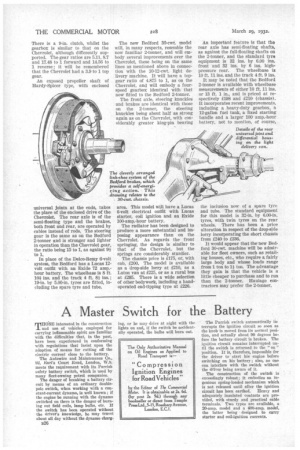A Master Switch for the Battery
Page 44

If you've noticed an error in this article please click here to report it so we can fix it.
rillIdSE interested in the construction 1 and use of vehicles employed for carrying inflammable spirit are familiar with the difficulties that, in the past, have been experienced in conforming with regulations that insist upon the adoption of means for cutting off the electric current close to the battery.
The Autowire and Maintenance Co., 92, Earl's Court Road, London, W.8, meets the requirement with its Parrish safety battery switch, which is used by many fleet-owning petrol companies.
The danger of breaking a battery circuit by means of an ordinary doublepole switch, when working with a constant-current dynamo, is well known ; if the engine be running with the dynamo switched on there is the danger of burning out field coils, lamp bulbs, etc. If the switch has been operated without the driver's knowledge, he may travel about all day without the dynamo charg n26 ing, or he may drive at night with the lights on and, if the switch be accidentally operated, the bulbs will burn out. The Parrish switch automatically interrupts the ignition circuit so soon as the knob is moved from its normal position, and actually about 90 degrees before the battery circuit is broken. The ignition circuit remains interrupted until the switch is returned to the " on " position. It is, therefore, impossible for the driver to start his engine before switching on his battery; also, no one can interfere with the switch without the driver being aware of it.
The construction of the switch is exceedingly robust ; it embodies an ingenious spring-loaded mechanism which is not released until after the ignition circuit has been earthed. Heavy and adequately insulated contacts are provided, with sturdy and practical cable terminals. Two types are available, a 20-amp. model and a 400-amp, model, the latter being designed to carry starter and coil-ignition currents.




































































































